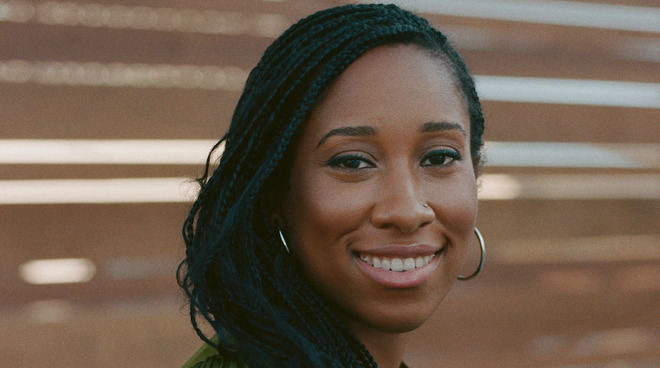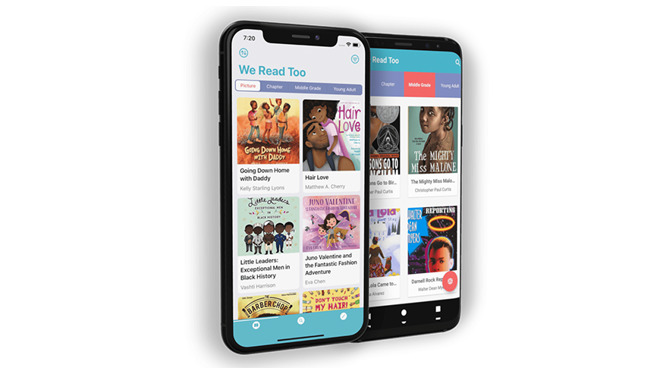'We Read Too' app developer uses love of coding to promote Black literature
Apple profiles Kayla Thomas, the developer who brought "We Read Too," to the App Store to give youth of color a way to find literature that best represents their experience.

Image Credit: Apple
"We Read Too" was created in 2014 and is a directory of hundreds of picture, chapter, middle school, and young adult books written by authors of color featuring main characters of color.
As a child, Thomas noted that the book fairs, libraries, and book stores she attended lacked diversity. While she didn't know how to code at the time, she already began dreaming up ways to solve the problem.
"I was going to the library and bookstores and book fairs in school, and I would see a very specific set of books," Thomas says. "By the time I got to high school, I started to get really frustrated wondering why there weren't any books that I was being exposed to that had Black characters, or were by Black authors. I started doing my own research and realized that those books existed -- they just weren't on bestseller lists, or displayed in the library or at the bookstore."
In 2014 she launched "We Read Too" to highlight the issue. She hoped that the app would be a valuable resource to help point readers to literature that offered Black representation.

Image credit: WeReadToo.com
Thomas reminds people that technology can't solve the diversity problem alone but hopes that it provides ease of access to Black literature for young readers.
"Once I realized that anyone can create an app, it was a huge moment for me to understand that I can build real things that people can use and put it out for them to be able to access," she says. "Technology can sometimes seem like such a black box, this magical thing. But once the veil was ripped away, I realized I could build something that could potentially solve problems."
Thomas, who also works on the popular meditation app Calm, also discusses how coding can be used as a creative outlet.
"Coding is a mesh between the logical and the creative, because the act of writing code can also be like writing poetry or something else," Thomas says. "You're also actually building something when you code, so it's a really creative process."
Apple reached out to Thomas to ask her what trends she's noticed in Black literature.
Thomas notes that she's starting to see Black autobiographical books focused on teenagers released, and names "Black Girl Unlimited" by Echo Brown and "All Boys Aren't Blue" by George M. Johnson.
"Both are must-reads and can help both young folks and adults alike unpack issues of identity, mental health, and trauma," she says.
She's also seen an increase in books covering Blackness and Queerness in young adult literature. She suggests "Felix Ever After" by Kacen Callender," "You Should See Me in a Crown" by Leah Johnson, and "Pet" by Akwaeke Emezi. All three books focus on the Black LGBTQIA experience, which is often overlooked in queer spaces.
She also notes an uptick in science fiction, fantasy, and world-building books that feature black characters. 2020 saw the debut of two novels that Thomas recommends, "A Song of Wraiths and Ruin" by Roseanne A. Brown and "A Song Below Water" by Bethany C. Morrow.
"Often speculative fiction helps readers imagine new worlds, possibilities, and futures, and it's essential that these books do not create worlds where Black people no longer exist."
During February, Apple will be marking Black History Month via its stores in the United States, with a number of Today at Apple sessions scheduled to take place throughout February to celebrate culture, by showing how people can use an iPhone or iPad to create new works.

Image Credit: Apple
"We Read Too" was created in 2014 and is a directory of hundreds of picture, chapter, middle school, and young adult books written by authors of color featuring main characters of color.
As a child, Thomas noted that the book fairs, libraries, and book stores she attended lacked diversity. While she didn't know how to code at the time, she already began dreaming up ways to solve the problem.
"I was going to the library and bookstores and book fairs in school, and I would see a very specific set of books," Thomas says. "By the time I got to high school, I started to get really frustrated wondering why there weren't any books that I was being exposed to that had Black characters, or were by Black authors. I started doing my own research and realized that those books existed -- they just weren't on bestseller lists, or displayed in the library or at the bookstore."
In 2014 she launched "We Read Too" to highlight the issue. She hoped that the app would be a valuable resource to help point readers to literature that offered Black representation.

Image credit: WeReadToo.com
Thomas reminds people that technology can't solve the diversity problem alone but hopes that it provides ease of access to Black literature for young readers.
"Once I realized that anyone can create an app, it was a huge moment for me to understand that I can build real things that people can use and put it out for them to be able to access," she says. "Technology can sometimes seem like such a black box, this magical thing. But once the veil was ripped away, I realized I could build something that could potentially solve problems."
Thomas, who also works on the popular meditation app Calm, also discusses how coding can be used as a creative outlet.
"Coding is a mesh between the logical and the creative, because the act of writing code can also be like writing poetry or something else," Thomas says. "You're also actually building something when you code, so it's a really creative process."
Apple reached out to Thomas to ask her what trends she's noticed in Black literature.
Thomas notes that she's starting to see Black autobiographical books focused on teenagers released, and names "Black Girl Unlimited" by Echo Brown and "All Boys Aren't Blue" by George M. Johnson.
"Both are must-reads and can help both young folks and adults alike unpack issues of identity, mental health, and trauma," she says.
She's also seen an increase in books covering Blackness and Queerness in young adult literature. She suggests "Felix Ever After" by Kacen Callender," "You Should See Me in a Crown" by Leah Johnson, and "Pet" by Akwaeke Emezi. All three books focus on the Black LGBTQIA experience, which is often overlooked in queer spaces.
She also notes an uptick in science fiction, fantasy, and world-building books that feature black characters. 2020 saw the debut of two novels that Thomas recommends, "A Song of Wraiths and Ruin" by Roseanne A. Brown and "A Song Below Water" by Bethany C. Morrow.
"Often speculative fiction helps readers imagine new worlds, possibilities, and futures, and it's essential that these books do not create worlds where Black people no longer exist."
During February, Apple will be marking Black History Month via its stores in the United States, with a number of Today at Apple sessions scheduled to take place throughout February to celebrate culture, by showing how people can use an iPhone or iPad to create new works.

Comments